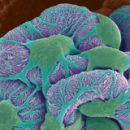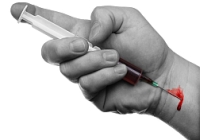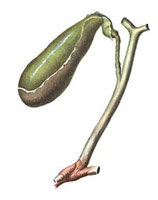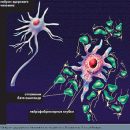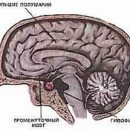Description of hepatitis, the main symptoms of all available types of viral hepatitis, their main manifestations, caused complications and rarely encountered types - G and F.
Content
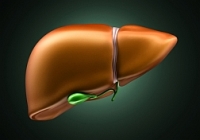 Hepatitis call the general pathology of the liver (from Latin «Gear» — Liver), acute and chronic nature, various origin. Such a disease can be caused by intrahepatic changes, as well as various infections. There are several types of infectious hepatitis: A, B, C, D, E, F, G.
Hepatitis call the general pathology of the liver (from Latin «Gear» — Liver), acute and chronic nature, various origin. Such a disease can be caused by intrahepatic changes, as well as various infections. There are several types of infectious hepatitis: A, B, C, D, E, F, G.
Hepatitis may be present in the clinical paintings of diseases such as yellow fever, AIDS, rubella, Epstein-Barra virus, cytomegalovirus. Radiant hepatitis is possible, as an integral continuation of radiation sickness, as well as as a result of autoimmune pathologies. Bacterial hepatitis is manifested in leptospirosis and syphilis. The form of toxic hepatitis can be: alcoholic, drugs or in poisoning by various chemicals.
The main symptoms of viral hepatitis
Due to the fact that hepatitis is one of the main components of many diseases, then its clinic is difficult to observe, because it is intertwined with the symptoms of the main disease. Consider viral hepatitis in «pure form»: which is not developing under the influence of poisoning or irradiation, but through a classified viral infection.
- Botkin's disease or hepatitis A can demonstrate forms with the presence of jaundice, without it, as well as with a hidden asymptomatic flow. Common signs of the disease are temperature, weakness, pain in the right hypochondrium and muscles, diarrhea, vomiting, increase in liver in size and darkening of urine. There is a refusal of food, intense itching. The difficult course is manifested by serious intoxication and dyspepsia, beginning hepatic encephalopathy, the appearance of edema, ascites, tachycardia, rash, hemorrhagic syndrome.
- Hepatitis in very similar symptomatics with hepatitis A. Only jaundice joins, which is almost always present in the clinical picture of the disease. Possible rash on the skin, characterized by itching. The disease develops much rapidly and harder than the form A, the jaundice increases gradually, worsening the general condition of the patient. Chronic flow can develop to the state of the hepatic coma and liver cirrhosis.
- Hepatitis C is considered one of the most severe types of viral hepatitis and has eleven main genotypes. The disease begins with a simple flu clinic. Further symptoms are similar to other types, characterized such asthenic manifestations as increased fatigue, low performance, weakness, bad sleep. Jaundice may be present, but it may not be. Heavy forms of the course of the disease lead to cirrhosis of the liver or cancer.
- Hepatitis D (Delta) — Leniv virus, which, when infected, can leave the limits of the hepatic cell for further distribution only with the help of hepatitis virus proteins. Therefore, symptoms repeats the flow of hepatitis B, but in more severe manifestations, lesions of the hepatic tissue are more massive. Possible pain in the field of liver, variable pain of large joints — so-called migratory, weakness, temperature, nausea, decreased appetite. Next, the jaundice comes, increasing the boundaries of the liver and spleen, as well as bringing with them increasing general intoxication. The clinic can proceed rapidly (lightning), leading to death, or move into a chronic form with constant cirrhosis of the liver.
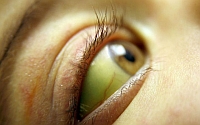 Hepatitis E clinically similar to the type A, but the difficult course of the disease leads to a fatal outcome much more often than when hepatitis A. Jaundice, anorexia is observed (full loss of appetite and refusal of food), increased sensitive liver, discomfort and soreness of the stomach and abdomen, nausea, vomiting, fever. Rarely rapid flow leads to the development of hepatic encephalopathy, acute liver failure and death. Possible hemorrhagic syndrome with sufficiently significant bleeding.
Hepatitis E clinically similar to the type A, but the difficult course of the disease leads to a fatal outcome much more often than when hepatitis A. Jaundice, anorexia is observed (full loss of appetite and refusal of food), increased sensitive liver, discomfort and soreness of the stomach and abdomen, nausea, vomiting, fever. Rarely rapid flow leads to the development of hepatic encephalopathy, acute liver failure and death. Possible hemorrhagic syndrome with sufficiently significant bleeding.- Hepatitis F — Reparatively young and poorly studied pathology. The hepatitis virus is similar to its manifestations for adenovirus. Symptoms repeats hepatitis A and C, the sharp period is almost always asymptomic, but the progression of the disease leading to cirrhosis or hepatocarcinoma, for hepatitis F is not characteristic.
- Hepatitis G is also still little known medicine, due to the rare infection. The disease occurs in a slight form, with moderate intoxication. The jaundice period is present, but it is not protracted — Approximately 21 days. Clinical changes are subject to only liver, other systems and organs remain unchanged, occasionally possible dysfunction of the gallbladder.
Rare hepatitis types G and F are very common in the CIS countries and Europe. Therefore, cases of the disease are not so much, which does not allow fully familiar with the course of the disease.

